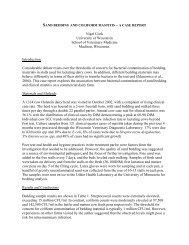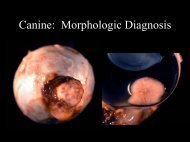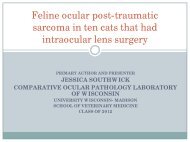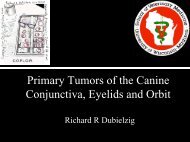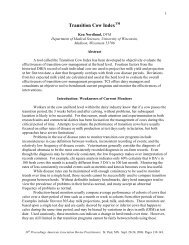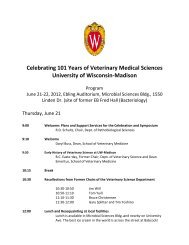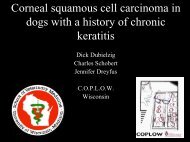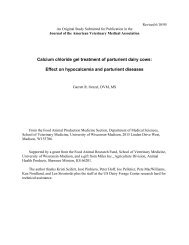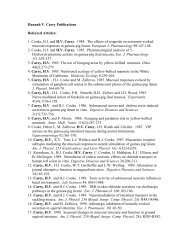Subacute Ruminal Acidosis in Dairy Herds - University of Wisconsin ...
Subacute Ruminal Acidosis in Dairy Herds - University of Wisconsin ...
Subacute Ruminal Acidosis in Dairy Herds - University of Wisconsin ...
Create successful ePaper yourself
Turn your PDF publications into a flip-book with our unique Google optimized e-Paper software.
Preconvention Sem<strong>in</strong>ar 7A: <strong>Dairy</strong> Herd Problem Investigation Strategies:Lameness, Cow Comfort, and <strong>Rum<strong>in</strong>al</strong> <strong>Acidosis</strong>(Holste<strong>in</strong> steer)8.07.57.0Feed and waterre-<strong>in</strong>troduced<strong>Rum<strong>in</strong>al</strong> pH6.56.05.55.0Accidentallylocked away fromfeed and water4.5-12 -6 0 6 12 18 24 30 36 42 48 54 60 66 72 78 84Time from Onset, HoursFigure 6. <strong>Rum<strong>in</strong>al</strong> pH after feed deprivation <strong>in</strong> a Holste<strong>in</strong> steer. Unpublished data, PrenticeSchaefer, and Oetzel, 2000.Low rum<strong>in</strong>al pH dur<strong>in</strong>g SARA reduces the number <strong>of</strong> species <strong>of</strong> bacteria <strong>in</strong> the rumen,although the metabolic activity <strong>of</strong> the bacteria that rema<strong>in</strong> is very high (Garry, 1996). Protozoalpopulations are also limited as rum<strong>in</strong>al pH approaches 5.0. When fewer species <strong>of</strong> bacteria andprotozoa are present, the rum<strong>in</strong>al micr<strong>of</strong>lora are less stable and less able to ma<strong>in</strong>ta<strong>in</strong> normalrum<strong>in</strong>al pH dur<strong>in</strong>g periods <strong>of</strong> sudden dietary changes (Garry, 1996). Thus, pre-exist<strong>in</strong>g SARAcould <strong>in</strong>crease the risk for acute rum<strong>in</strong>al acidosis <strong>in</strong> the event <strong>of</strong> accidental <strong>in</strong>gestion <strong>of</strong> excessiveamounts <strong>of</strong> gra<strong>in</strong>.<strong>Rum<strong>in</strong>al</strong> atony. Additional drops <strong>in</strong> rum<strong>in</strong>al pH may result <strong>in</strong> complete rum<strong>in</strong>al atony. Thisresponse decreases absorption <strong>of</strong> acids by keep<strong>in</strong>g them away from the rum<strong>in</strong>al wall. In essence,the animal now senses that systemic acid-base balance is be<strong>in</strong>g jeopardized by the absorption <strong>of</strong>lactic acid, so it seeks to preserve the whole animal at the expense <strong>of</strong> the rumen. <strong>Rum<strong>in</strong>al</strong> pHwill drop even faster now - to 5.0 or below. At this po<strong>in</strong>t, the animal is <strong>in</strong> acute rum<strong>in</strong>al acidosis,which can be life-threaten<strong>in</strong>g. The cow is “bett<strong>in</strong>g her life” that the rumen will run out <strong>of</strong> itssupply <strong>of</strong> fermentable carbohydrates before death occurs. This may or may not be true,depend<strong>in</strong>g on the load <strong>of</strong> carbohydrates consumed before she received the signal to stop eat<strong>in</strong>g.Pathophysiology <strong>of</strong> <strong>Rum<strong>in</strong>al</strong> <strong>Acidosis</strong> <strong>in</strong> <strong>Dairy</strong> CattleThe rum<strong>in</strong>al epithelial cells are not protected by mucus (as abomasal cells are), so they arevulnerable to the chemical damage by acids. Thus, low rum<strong>in</strong>al pH leads to rumenitis, erosion,and ulceration <strong>of</strong> the rum<strong>in</strong>al epithelium. Rumenitis is the fundamental lesion <strong>of</strong> SARA, and itleads to chronic health problems. In contrast, systemic acidemia is the fundamental lesion <strong>of</strong>acute rum<strong>in</strong>al acidosis, and acute death is its ma<strong>in</strong> health risk.Cl<strong>in</strong>ical signs from the health effects <strong>of</strong> SARA are delayed <strong>in</strong> onset from the time <strong>of</strong> the lowrum<strong>in</strong>al pH <strong>in</strong>sult. These signs are the result <strong>of</strong> a pathophysiological cascade <strong>of</strong> events thatbeg<strong>in</strong>s with rumenitis. Once the rum<strong>in</strong>al epithelium is <strong>in</strong>flamed, bacteria may colonize the<strong>University</strong> <strong>of</strong> Wiscons<strong>in</strong>, School <strong>of</strong> Veter<strong>in</strong>ary Medic<strong>in</strong>e, 2015 L<strong>in</strong>den Drive, Madison, WI 5370696



